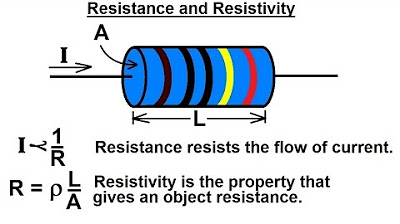Chapter 1 - Fundamentals of Electric Circuits
Summary
TLDRThis script introduces fundamental electrical concepts, focusing on charge, measured in coulombs, and its relation to electrons. It explains current as the rate of charge change over time, measured in amperes. The script differentiates between direct current (DC) and alternating current (AC), and discusses voltage as the force needed to move electrons, measured in volts. It also covers the relationship between charge, current, voltage, and power, with power being the rate of energy change over time, measured in watts. The script concludes with an introduction to circuit components, distinguishing between passive elements like resistors and active elements like batteries.
Takeaways
- 🔋 The concept of charge is fundamental in electricity, with charges being either positive or negative, typically represented by protons and electrons.
- ⚡ The unit of charge is the coulomb (C), where 1 coulomb is equivalent to 6.24 x 10^18 electrons.
- ⚡️ One electron has a charge of 1.602 x 10^-19 coulombs, indicating that a coulomb is a substantial amount of charge.
- 🕒 The change in charge over time is referred to as current, symbolized by 'I', and is measured in amperes (A), which is coulombs per second.
- 📈 The total charge (Q) is calculated by integrating the current (I) over a period of time, represented as Q = ∫ I dt from t0 to T.
- 🔌 There are two types of current: direct current (DC), which flows in one direction, and alternating current (AC), which changes direction periodically.
- 🔌 Voltage, or electromotive force (EMF), is the force required to move electrons and is measured in volts (V).
- 🔌 The voltage can be thought of as the 'height' of a waterfall, where a higher voltage results in a greater current flow.
- ⚙ The relationship between power, energy, and time is expressed as power (P) being the rate of energy change over time, measured in watts (W).
- 💡 Power can be calculated as the product of voltage (V) and current (I), with the formula P = V * I.
- 💡 The energy consumed by an electrical device can be determined by integrating power over time, with the formula W = ∫ P dt from t0 to T, measured in joules (J).
Q & A
What is the fundamental difference between positive and negative charge?
-Charge can be either positive or negative, typically referring to protons and electrons respectively. Protons carry a positive charge, while electrons carry a negative charge.
How is the quantity of charge measured?
-The quantity of charge is measured in coulombs, denoted by the letter 'C'. One coulomb is equivalent to 6.24 times 10 to the 18th electrons.
What is the relationship between an electron's charge and the coulomb?
-One electron has a charge of 1.602 times 10 to the negative 19th power coulombs, indicating that one coulomb is made up of a vast number of electrons.
What is the mathematical representation of current?
-Current is represented by the letter 'I' and is mathematically defined as the change in charge with respect to time, expressed as \( \frac{dQ}{dt} \).
What unit is used to measure current?
-Current is measured in amperes, often shortened to 'amps', which is equivalent to coulombs per second.
How does the concept of current relate to the flow of water?
-In the context of water flow, current refers to how fast the water is moving. Similarly, in electricity, current refers to the flow of charge, which is the movement of electrons.
What are the two types of current and how do they differ?
-There are two types of current: direct current (DC) and alternating current (AC). DC flows in one direction, while AC changes direction periodically.
What is voltage and how is it measured?
-Voltage, sometimes referred to as electromotive force (EMF), is the force needed to move an electron and is measured in volts (V).
How is the relationship between voltage, current, and charge visualized?
-The relationship can be visualized as a waterfall where the height represents voltage, the flow of water represents current, and the water itself represents charge.
What is the formula for power in terms of voltage and current?
-Power (P) is calculated as the product of voltage (V) and current (I), expressed as \( P = V \times I \), and is measured in watts (W).
How is energy related to power and time?
-Energy (W) is the integral of power over time, which can be expressed as \( W = \int P \, dt \), and is measured in joules (J).
What is the cost of running a 13-watt light bulb for one day in Iowa, considering the electricity cost is 0.12 dollars per kilowatt-hour?
-The cost would be approximately 0.037 dollars, calculated by converting the power from watts to kilowatts, multiplying by the time in hours, and then by the cost per kilowatt-hour.
Outlines

このセクションは有料ユーザー限定です。 アクセスするには、アップグレードをお願いします。
今すぐアップグレードMindmap

このセクションは有料ユーザー限定です。 アクセスするには、アップグレードをお願いします。
今すぐアップグレードKeywords

このセクションは有料ユーザー限定です。 アクセスするには、アップグレードをお願いします。
今すぐアップグレードHighlights

このセクションは有料ユーザー限定です。 アクセスするには、アップグレードをお願いします。
今すぐアップグレードTranscripts

このセクションは有料ユーザー限定です。 アクセスするには、アップグレードをお願いします。
今すぐアップグレード関連動画をさらに表示

Class 12th – Electron theory of Electrification | Electric Charges and Fields | Tutorials Point

Circuits - Current, Resistance and Voltage explained [Year 11/Grade 10]

AP Physics 2 Vid1 - Intro To Electrostatics

Física - Eletrodinâmica: corrente elétrica

Electrical Engineering: Basic Concepts (3 of 7) Electric Current (Conventional vs Electrical Flow)

Electrical Engineering: Basic Laws (1 of 31) Resistance and Resistivity
5.0 / 5 (0 votes)
